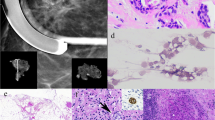Abstract
Background
In 2003, the American Joint Committee on Cancer (AJCC) initiated the 6th edition staging criteria, including pN0(i+) and pN1mi categories for breast cancer. However, the clinical significance of these categories is debated in the literature.
Methods
A prospective registry was used to identify patients staged with sentinel lymph node (SLN) biopsy. SLN evaluation included routine serial sectioning and immunohistochemical stains. SLN biopsies performed before January 2003 were restaged according to the AJCC’s 6th edition criteria.
Results
Of 954 SLN biopsies identified, on review, 491 N0i-, 86 N0i+, 73 N1mi, 146 N1a, 29 N2a, and 11 N3a patients were available for analysis with a median follow-up of 45.4 months. Significant prognostic and therapeutic differences existed between the groups. Differences in overall survival (OS) and recurrence-free survival (RFS) were only noted when the size of the metastases reached the N1a level. There were no statistically significant differences in OS or RFS between N0(i−) and N0(i+) or N1mi disease. Cases that were N0(i+) or N1mi were more likely to have other poor prognostic factors and to receive more aggressive therapy.
Conclusion
SLN biopsy allows a more sensitive evaluation of lymph nodes for metastatic cells. This has led to the increased identification of very small axillary metastases. While the new microstaging categories are not yet clearly associated with a significantly decreased OS or DFS in this series, they are associated with other poor prognostic factors and more local/regional and systemic therapy. Further analysis of the microstaging categories is needed.

Similar content being viewed by others
References
Fisher ER, et al. Pathologic findings from the National Surgical Adjuvant Breast Project protocol B-06. 10−year pathologic and clinical prognostic discriminants. Cancer 1993; 71:2507–14
Russo J, et al. Predictors of recurrence and survival of patients with breast cancer. Am J Clin Pathol 1987; 88:123–31
NIH consensus conference. Treatment of early-stage breast cancer. JAMA 1991; 265:391–5
Cabanas RM. An approach for the treatment of penile carcinoma. Cancer 1977; 39:456–66
Giuliano AE, et al. Lymphatic mapping and sentinel lymphadenectomy for breast cancer. Ann Surg 1994; 220:391–8; discussion 398–401
Krag DN, et al. Surgical resection and radiolocalization of the sentinel lymph node in breast cancer using a gamma probe. Surg Oncol 1993; 2:335–9; discussion 340
Wilke LG, et al. Surgical complications associated with sentinel lymph node biopsy: results from a prospective international cooperative group trial. Ann Surg Oncol 2006; 13:491–500
Silverstein MJ, et al. Image-detected breast cancer: state of the art diagnosis and treatment. J Am Coll Surg 2005; 201:586–97
Dowlatshahi, et al. Lymph node micrometastases from breast carcinoma. Cancer 1997; 80:1188–97
Mullenix PS, et al. The association of cytokeratin-only-positive sentinel lymph nodes and subsequent metastases in breast cancer. Lancet 2005; 189:606–9; discussion 609
Cote RJ, et al. Role of Immunohistochemical detection of lymph-node metastases in management of breast cancer. Lancet 1999; 354(9182):896–900
Susnik B, Frkovic-Grazio S, Bracko M. Occult micrometastases in axillary lymph nodes predict subsequent distant metastases in stage I breast cancer: a case-control study with 15-year follow-up. Ann Surg Oncol 2004; 11:568–72
Singletary E. Early-stage invasive breast cancer: isolated tumor cells in axillary lymph nodes, peripheral blood, and bone marrow. Gen Surg News 2006; 33:17–20
Pugliese MS, et al. Accuracy of intraoperative imprint cytology of sentinel lymph nodes in breast cancer. Am J Surg 2006; 192:516–9
Pugliese MS, et al. The utility of intraoperative evaluation of sentinel lymph nodes in breast cancer. Ann Surg Oncol 2007; 14:1024–30
Lyman GH, et al. American Society of Clinical Oncology guideline recommendations for sentinel lymph node biopsy in early-stage breast cancer. J Clin Oncol 2005; 23:7703–20
Morton DL, et al. Improved long-term survival after lymphadenectomy of melanoma metastatic to regional nodes. Analysis of prognostic factors in 1134 patients from the John Wayne Cancer Clinic. Ann Surg 1991; 214:491–9; discussion 499–501
Moore MP, Kinne DW. Axillary lymphadenectomy: a diagnostic and therapeutic procedure. J Surg Oncol 1997; 66:2–6
Houvenaeghel G, et al. Micrometastases in sentinel lymph node in a multicentric study: predictive factors of nonsentinel lymph node involvement–Groupe des Chirurgiens de la Federation des Centres de Lutte Contre le Cancer. J Clin Oncol 2006; 24:1814–22
Van Zee KJ, et al. A nomogram for predicting the likelihood of additional nodal metastases in breast cancer patients with a positive sentinel node biopsy. Ann Surg Oncol 2003; 10:1140–51
Colleoni M, et al. Size of breast cancer metastases in axillary lymph nodes: clinical relavance of minimal lymph node involvement. J Clin Oncol 2005; 23:1379–89
Tan LK, et al. Occult axillary metastases in breast cancer are prognostically significant: results in 368 node-negative patients with 20-year follow-up. J Clin Oncol 2008; 26:1803–9
Cox CE, et al. Significance of sentinel lymph node micrometastases in human breast cancer. J Am Coll Surg 2008; 206:261–8
Author information
Authors and Affiliations
Corresponding author
Rights and permissions
About this article
Cite this article
Pugliese, M.S., Beatty, J.D., Tickman, R.J. et al. Impact and Outcomes of Routine Microstaging of Sentinel Lymph Nodes in Breast Cancer: Significance of the pN0(i+) and pN1mi Categories. Ann Surg Oncol 16, 113–120 (2009). https://doi.org/10.1245/s10434-008-0121-x
Received:
Revised:
Accepted:
Published:
Issue Date:
DOI: https://doi.org/10.1245/s10434-008-0121-x




